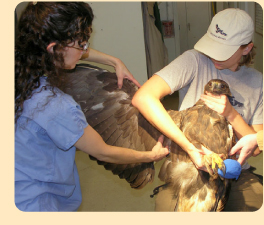
The birds at the National Aviary are ambassadors for their wild counterparts and much can be done to contribute to conservation programs that directly benefit the survival of threatened and endangered species.
One such effort involving the Aviary’s veterinary hospital took place in 2007 when a critically injured wild golden eagle was brought to the Aviary after sustaining a life-threatening injury from a coyote leg trap. The eagle, later identified as Eagle 41, received much-needed surgery to repair damaged muscle, tendons and bone, followed by 16 weeks of intensive wound management. Treatment also included physical therapy to help the leg return to full function. Eagle 41 made a complete recovery and was released back into the wild after being fitted with a satellite-tracking device to monitor his progress.
Read the full story of Eagle 41 to find out how he is part of an important research study on windpower and eastern golden eagle migration.
The National Aviary has also participated in a wild flamingo research project in El Cuyo in the Yucatan, Mexico. Caribbean flamingos are endangered species due to multiple environmental hazards and disease outbreaks. Each year over 500 baby flamingos are caught by a research team to place identification bands on the birds and collect vital information. As a result of multiple long-term research programs, the numbers of flamingos are increasing slowly. In 2004 Dr. Fish joined the research team and organized a donation drive to obtain enough medical supplies from veterinarians and physicians in Pittsburgh to completely stock the hospital on the wildlife preserve. Once in Mexico, Dr. Fish helped make a field triage station to treat injured flamingos and provide intensive care for them.
Species Survival Plan — Conservation of endangered species in zoos.

 The birds at the National Aviary are ambassadors for their wild counterparts and much can be done to contribute to conservation programs that directly benefit the survival of threatened and endangered species.
The birds at the National Aviary are ambassadors for their wild counterparts and much can be done to contribute to conservation programs that directly benefit the survival of threatened and endangered species.







